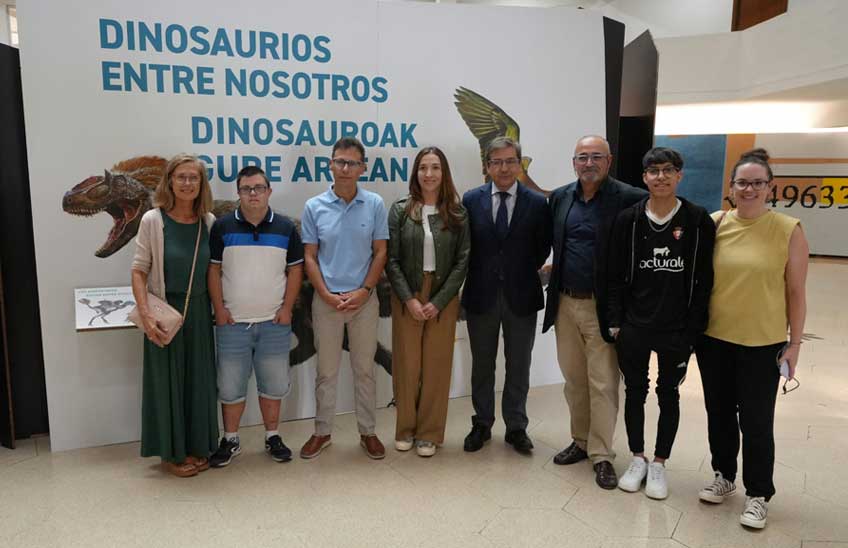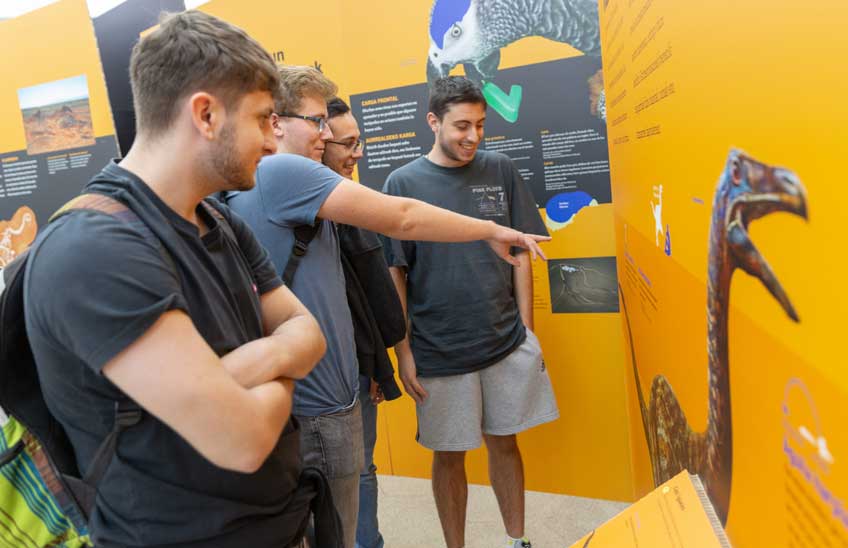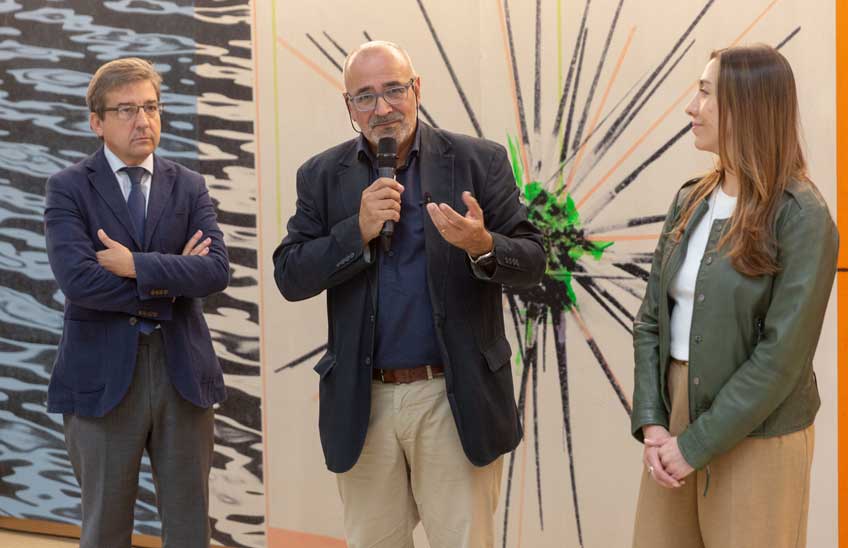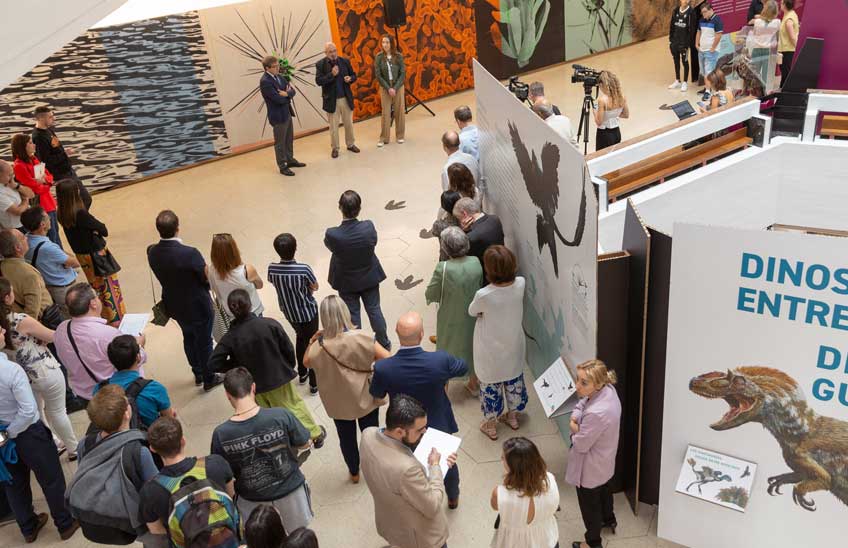The Science Museum of the University of Navarra brings to Spain the exhibition "Dinosaurs Among Us".
The sample, created by the American Museum of Natural History (New York), will remain in the Science Building of the University from October 6 to November 25.

PhotoManuelCastells
/(from left to right): Elvira Lacunza (educational director of the Centro de Education Especial El Molino), Alejandro Alzugaray (student of the Centro de Education Especial El Molino), Fidel Torcida (director of the Dinosaur Museum of Salas de los Infantes), Alejandra Castellanos (General Manager of development strategic of department of development global of the American Museum of Natural History in New York), Carlos Salvador (Councilman of Education, Equality and Cultural Diversity of the Pamplona City Council), Ignacio López-Goñi (director of the Science Museum of the University of Navarra), Lino Valero (student of the Center for Special Education El Molino) and Natalia Galban (professor of the Center for Special Education El Molino).
05 | 10 | 2023
The next time you dodge a pigeon on the sidewalk, see a sparrow eating on a patio or order chicken for dinner, know that you' ve just encountered a modern dinosaur. Dinosaurs didn't really disappear from Earth because, although most became extinct, their evolutionary bequest lives on today through birds.
The Museo de Ciencias Universidad de Navarra brings to Spain the exhibition "Dinosaurs Among Us", a sample created by the American Museum of Natural History (New York) that explains the uninterrupted connection between modern birds and the dinosaurs that dominated the planet for 170 million years. The panels feature large-scale color illustrations of extinct and recently discovered dinosaur species presented as they would have looked in real life.

The exhibition can be visited free of charge at the Sciences Building of the University of Navarra from October 6 to November 25, at schedule from Monday to Friday from 9 am to 8 pm and on Saturdays from 9 am to 2 pm. School visits will take place Monday through Friday at schedule from 9 a.m. to 1 p.m. prior to registration.
On the other hand, the Science Museum of the University of Navarra has organized various activities for all audiences around this theme, such as talks with experts, family workshops and an educational program for schools, which can be consulted on its website.
"The exhibition is part of a broader initiative that seeks to foster a scientific conversation at various levels. We have organized training for teachers and teacher training students, workshops for schools, open lectures covering topics ranging from Darwin and Evolution to Geology and Paleontology. We are especially pleased with the partnership of the students of high school El Molino who have helped us with the adapted posters and the Dinosaur Museum of Salas de Infantes that has donated fossils from its collection to enrich the visit", explains Marie-anne Reynell, director of development of the Science Museum of the University of Navarra.
Modern birds are dinosaurs living among us
"Dinosaurs Among Us" probes the boundary that exists between the animals we call "birds" and those we traditionally know as "dinosaurs." Living birds belong to a group called "Dinosauria" that includes extinct dinosaurs and all of their living descendants, which is why most scientists have come to the consensus that birds are a species of dinosaur just as we are a species of mammal. When looking at the paleontological and biological evidence, the public can appreciate the links between dinosaurs and birds, as well as when looking at their reproduction, their physical Structures and the evolution of their flight, proving that birds are indeed dinosaurs living among us.

"Dinosaurs Among Us" is organized by the American Museum of Natural History in New York with the support of the North Museum of Nature and Science (USA), the Philip J. Currie Museum (Canada), the Museo de Ciencias Universidad de Navarra (Spain), and the Universum Museo de las Ciencias de la UNAM (Mexico). For the exhibition in Pamplona we have counted with the support of sponsorship of Pamplona City Council, the Spanish Foundation for Science and Technology (FECYT) / Ministry of Science and Innovation, Acunsa and Caja Rural de Navarra, as well as with the partnership of the Ciganda Ferrer Foundation-high school El Molino and the Dinosaur Museum of Salas de los Infantes (Burgos).
This edition of the exhibition is at position by Dr. Akinobu Watanabe, researcher associate of the American Museum of Natural History and Adjunct Professor of Anatomy at the New York Institute of Technology. It is adapted from an original Museum exhibition of the same name and was position by Mark Norell, curator emeritus of department of Paleontology.
The American Museum of Natural History, founded in 1869 with a dual mission statement of research scientific and Education scientific, is one of the world's foremost scientific, educational and cultural institutions. The museum encompasses more than 40 permanent exhibition halls, galleries for temporary exhibitions, the Rose Center for Earth and Space which includes the Hayden Planetarium, and the Richard Gilder Center for Science, Education and Innovation.

The museum's scientists draw on a permanent collection of class worldwide that includes more than 34 million specimens and artifacts, some of which are billions of years old, and one of the largest natural history libraries in the world. Through its Richard Gilder School of postgraduate program , the museum offers two independent degree-granting programs, unique in any museum in the United States: the doctoral program in Comparative Biology and the Master of Arts (MAT) program at teaching with an emphasis in Earth Sciences. For more information, you can visit their website at amnh.org.




